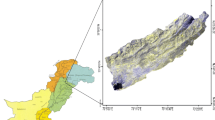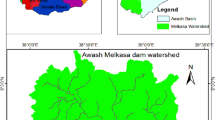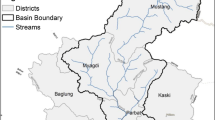Abstract
Sedimentation represents a serious threat to the dam and reduces its useable water storage and its life span. Due to erosion and sedimentation problems, a dam gradually loses its ability to store water for the purposes for which it was built. The Soil and Water Assessment Tool model (SWAT) was utilized to estimate the sediment yield in Wadi Al-Arab dam at the northern part of Jordan. In this research, two sediment transport relationships were developed: one for the sediment yield as a function of surface runoff and another for the sediment yield as a function of the slope, area of the watershed, and water discharge by using a statistical regression analysis on a set of hydraulic variables. The results showed that the reservoir storage is reduced with an annual rate of 0.093 MCM, and the accumulated sediment occupies 15% of the total storage capacity during a period of 32 years. The model also identified the location of high sediment yield within the study area, which is located at the western part of the watershed. The result of this study was compared with those of other investigators and with the actual sediment data. The difference in sediment yield between this study and actual sediment deposition was about 7%. Based on the results, it was found that SWAT model could be used to predict catchment soil erosion in watershed and sediment yield trapped behind similar dams.




















Similar content being viewed by others
Abbreviations
- ANSWERS:
-
Areal nonpoint source watershed environmental response simulation
- CN:
-
Curve number
- DEM:
-
Digital elevation model
- EUROSEM:
-
European Soil Erosion Model
- GIS:
-
Geographic information system
- HRU:
-
Hydrological response unit
- IDN:
-
Identification number
- MCM:
-
Million cubic meter
- MOA:
-
Ministry of Agriculture
- MUSLE:
-
Modified Universal Soil Loss Equation
- MWI:
-
Ministry of Water and Irrigation
- RUSLE:
-
Revised Universal Soil Loss Equation
- SCS:
-
Soil Conservation Service
- SSURGO:
-
Soil Survey Geographic Database
- STATSGO:
-
The State Soil Geographic Database
- SWAT:
-
Soil and Water Assessment Tool
- UTM:
-
The Universal Transverse Mercator coordinates system
- USDA:
-
US Department of Agriculture
- USLE:
-
Universal Soil Loss Equation
- WEPP:
-
Water Erosion Prediction Project
- WGS:
-
World Geodetic System
References
Arekhi S, Kaur R (2007) Evaluating long-term annual sediment yield estimating potential of GIS interfaced MUSEL model on two micro-watersheds. J Soil Water Conserv 6(4):153–161
Arnold JG, Moriasi DN, Gassman PW, Abbaspour KC, White MJ, Srinivasan R, Kannan N (2011) SWAT: model use, calibration, and validation. Trans ASABE 55(4):1491–1508
Babaei H, Nazari-Sharabian M, Karakouzian M, Ahmad S (2019) Identification of critical source areas (CSAs) and evaluation of best management practices (BMPs) in controlling eutrophication in the Dez River Basin. Environments 2019(6):20. https://doi.org/10.3390/environments6020020
Betrie GD, Mohamed YA, van Griensven A, Srinivasan R (2011) Sediment management modelling in the Blue Nile Basin using SWAT model. Hydrol Earth Syst Sci 15(3):807–818
Dutta S (2016) Soil erosion, sediment yield and sedimentation of reservoir: a review. Model Earth Syst Environ 2(3):123
Hadadin N (2015) Dams in Jordan current and future perspective. Canadian J Pure Appl Sci 9(1):3279–3290
Hadadin N (2016) Modeling of rainfall-runoff relationship in semi-arid watershed in the Central Region of Jordan. Jordan J Civil Eng 10(2):201
Hadadin N (2017) Variation in hydraulic geometry for stable versus incised streams in the Yazoo River basin–USA. Int J Sediment Res 32(1):121–126
Hallouz F, Meddi M, Mahé G, Alirahmani S, Keddar A (2018) Modeling of discharge and sediment transport through the SWAT model in the basin of Harraza (Northwest of Algeria). Water Sci 32(1):79–88
Ijam A, Al-Mahamid M (2012) Predicting sedimentation at Mujib dam reservoir in Jordan. Jordan J Civil Eng 6(4):448–463
Ijam A, Tarawneh E (2012) Assessing of sediment yield for Wala Dam catchment area in Jordan. Eur Water 38:43–58
Julien PY (1998) Erosion and sedimentation. Cambridge University Press
Julien PY (2002) River mechanics. Cambridge University Press
Kothyari UC, Jain SK (1997) Sediment yield estimation using GIS. Hydrol Sci J 42(6):833–843
Mulungu DM, Munishi SE (2007) Simiyu River catchment parameterization using SWAT model. Phys Chem Earth A/B/C 32(15-18):1032–1039
Nazari-Sharabian M, Taheriyoun M, Karakouzian M (2020) (2019). A sensitivity analysis of DEM resolution and effective parameters on runoff yield in the SWAT model – a case study. J Water Supply Res Technol AQUA 69(1):39–54. https://doi.org/10.2166/aqua.2019.044
Renard KG, Foster GR, Weesies GA, Porter JP (1991) RUSLE: revised universal soil loss equation. J Soil Water Conserv 46(1):30–33
Shaheen M (2017) Estimation of sediment yoeld at King Talal Dam- Jordan, thesis-the University of Jordan
Shatnawi A, Diabat A (2016) Siltation of Wadi Al-Arab reservoir using GIS techniques. Jordan J Civil Eng 10(4)
Singh HV, Kalin L, Srivastava P (2010) Effect of soil data resolution on identification of critical source areas of sediment. J Hydrol Eng 16(3):253–262
Walling DE (2006) Human impact on land–ocean sediment transfer by the world’s rivers. Geomorphology 79:192–216. https://doi.org/10.1016/j.geomorph.2006.06
Williams JR (1969) Flood routing with variable travel time or variable storage coefficients. Transact ASAE 12(1):100–0103
Wischmeier W, Smith DD (1978) Predicting rainfall erosion losses-a guide to conservation planning. United States Department of Agriculture, Maryland
Xu ZX, Pang JP, Liu CM, Li JY (2009) Assessment of runoff and sediment yield in the Miyun Reservoir catchment by using SWAT model. Hydrol Process 23(25):3619–3630
Author information
Authors and Affiliations
Corresponding author
Additional information
Responsible Editor: Amjad Kallel
Rights and permissions
About this article
Cite this article
Hadadin, N.A., Al-Adwan, S.R. Estimation of the sediment yield using hydrological assessment tool model: a case of Wadi Al-Arab Dam at the northern part of Jordan. Arab J Geosci 13, 380 (2020). https://doi.org/10.1007/s12517-020-05418-3
Received:
Accepted:
Published:
DOI: https://doi.org/10.1007/s12517-020-05418-3




